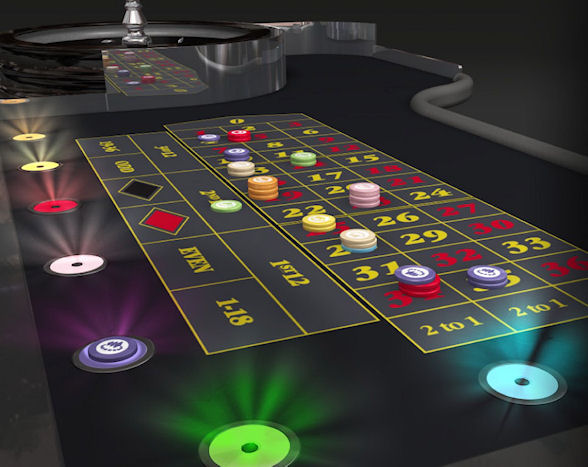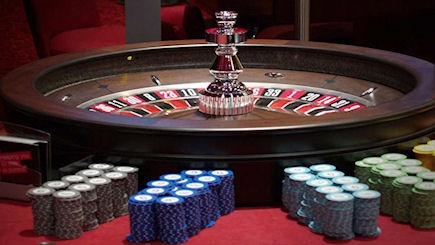This article first appeared in the Jul/Aug 2013 issue of World Gaming magazine.
A mainstay at casinos around the globe, roulette has long been a popular game for the casual visitor who wants to have a bit of fun without having to worry about learning any complicated rules. Fast and exciting, just about everyone that has ever stepped foot onto a casino floor has thrown in a sneaky bet hoping their number comes up. Most players have never stopped to think about the mechanics behind that fancy wheel. Let’s take a look.

Roulette is one of the most popular casino games in the world today and certainly one of the oldest, dating back as far as the 17th century. The game begins with the spinning of a wheel with 37 slots numbered 0 to 36 inclusive (some wheels have a 38th slot numbered 00). The wheel is spun in one direction and the ball is spun hard in the other direction along a rim at the top of the wheel. Eventually the ball slows and drops down into one of the numbered slots, and winning bets are decided. Back in 1873 British man Joseph Jagger, with the help of six accomplices, observed all six of the roulette wheels at a particular Monte Carlo casino and found that one had a significant bias. Using this to his advantage, he managed to win the phenomenal amount of two million French Francs, worth about US$5 million in today’s money. The randomness of wheels has improved so greatly over the years that the wheels of today are works of perfection, precision engineered to spin smoothly and give a true spin with a truly random result.
HISTORY OF ROULETTE
 The exact origins of the roulette wheel are difficult to trace but it is believed to have originated from French mathematician Blaise Pascal. In 1655, while attempting to create a perpetual motion machine, he created a roulette wheel as a by-product of his experiments. Although the perpetual motion machine was a failure, the roulette wheel survives to this day. For nearly two hundred years the roulette wheel existed with both a zero and double zero until two Frenchmen, Francois and Louis Blanc, introduced a single zero wheel to compete with existing casinos that offered zero and double zero wheels. Today, the double zero wheel can be found in the USA, Canada, South America and the Caribbean while the single zero wheel prevails everywhere else around the world.
The exact origins of the roulette wheel are difficult to trace but it is believed to have originated from French mathematician Blaise Pascal. In 1655, while attempting to create a perpetual motion machine, he created a roulette wheel as a by-product of his experiments. Although the perpetual motion machine was a failure, the roulette wheel survives to this day. For nearly two hundred years the roulette wheel existed with both a zero and double zero until two Frenchmen, Francois and Louis Blanc, introduced a single zero wheel to compete with existing casinos that offered zero and double zero wheels. Today, the double zero wheel can be found in the USA, Canada, South America and the Caribbean while the single zero wheel prevails everywhere else around the world.
WHY PLAY ROULETTE?
There is no doubt roulette is one of the most popular games in casinos across the globe, which is why the number of wheels in most established casinos has remained fairly steady over the past 15 to 20 years while the amount of blackjack or craps tables has tended to drop. In fact, Mar del Plata casino in Argentina boasts over 100 wheels – the most of any casino in the world! Roulette has been attracting crowds since the days those crazy 17th century French aristocrats were betting their fortunes on the game. As long as the game keeps attracting a crowd, casinos will keep it on the floor and roulette certainly knows how to do that! So what makes roulette so popular? There are three main reasons.
First of all, roulette is amongst the easiest of games in the casino to learn. Although many players like to keep track of patterns in the numbers that come up, the truth of the matter is every spin is random and independent of all spins that have come before. All a player has to do is pick their numbers and hope one of them comes up.
Roulette is also a great social game, with players all playing against the house rather than each other. They are also free to bet on the same number so they can cheer on their bet together. This brings us to the spinning of the ball, which brings with it tremendous excitement as the wheel slows and the ball starts bouncing around looking for its final resting place.
Anyone who plays regularly should be aware of the considerable difference between single zero wheels and double zero wheels. The single zero wheel offers the casino a house edge of 2.7 percent while double zero is almost double that at 5.3 percent – making it one of the more expensive of the common casino games.
THE MECHANICS OF A ROULETTE WHEEL
Many former US roulette wheel manufacturers, such as B.C. Wills, Tramble, Benteler and Rude, have ceased manufacturing wheels. In today’s market there are primarily two main manufacturers: TCS Huxley and Cammegh. Both companies have head offices in the United Kingdom where the wheels are manufactured.

A TCS Huxley wheel
TCS Huxley roulette wheels came onto the market over 30 years ago and quickly acquired a reputation as a quality product. As a result, their roulette wheels were extremely popular with casinos. In 1990, Cammegh roulette wheels came onto the market and today offer another quality wheel that is also proving to be very popular with casinos worldwide.
The engineering that goes into making the wheels of today is state-of-the-art and millimetre perfect, aiming for a truly random result every spin. The wheel itself is made up of many parts but there are two main components: the bowl, which is the external housing of the wheel and the rotor, which is the main spinning part of the wheel that sits in the bowl. The bowl contains the ball track the ball spins around on, the apron which is the lower ball track that houses the ball deflectors and the spindle that houses the wheel head. The bowl is approximately 32 inches in diameter in most wheels operating in casinos.
On the outer edge of the rotor circumference are the numbers and just inside the numbers are the pockets the ball lands in to decide the winning numbers. The pockets can be different styles, such as those separated by traditional frets, or scalloped pockets made of a single piece of solid aluminium. The frets of today tend to have more of a “low profile” with shallower pockets that allow the ball to bounce around a little bit more, adding to the random nature of the result.
The cone in the middle of the wheel is made from richly veneered MDF (medium density fibreboard) and sits on an aluminium carrier plate. The cone has a steep angle to ensure the ball will roll back and land on a number. We then have the turret which is attached to the middle of the wheel. These come in all shapes and sizes and can be tailor-made to a specific design if required by casinos. Generally, they have the manufacturer’s name on them and are quite a decorative part of the wheel. The turret is screwed on to the wheel and covers the height adjustment mechanism for the wheel. The height adjustment mechanism ensures that the rotor sits flush with the apron (inside of the bowl) to ensure that the ball will roll onto the rotor, then into a number pocket.
WHEEL ADVANCEMENTS
There is no doubt that wheels have come a long way in the past decade or so. On a recent visit to TCS Huxley in Sydney, WGM was given a first-hand look at the “Saturn” wheel. One of the features of this wheel is the very discreet in-rim sensor. The sensor collects data and sends the information to the display board to ensure that the correct winning numbers are displayed. Another role of the sensor is to ensure the wheel is unbiased and operating in a random manner. The information gathered is stored and analysed to ensure that there are no operating abnormalities.
In recent years we have seen the introduction of number display boards that give players a rundown of recent winning numbers. In-wheel sensors collect winning number data and relay the information to a high resolution LCD screen viewed by the players.
There has also been the introduction of chipper machines that have the ability to sort five hundred chips a minute. The dealer simply rakes all the losing bets into the chipper and by the time the winning bets have been paid, the chips have been sorted – colors and all! This greatly increases the spins per hour and makes the dealer’s job a lot easier. Another added feature is that the chipper can record data for tracking an individual player’s action as well as the result of the table in general.

TCS Huxley’s SuperNova tables are the latest in cutting edge technology
THE FUTURE OF ROULETTE
Considering the game of roulette has been around for over three centuries it is safe to assume that it will be around for a while to come. With all of the advances in roulette wheel manufacturing over the last few decades it is hard to imagine what more can be done to improve the game of roulette. That said, the pressure is on gaming manufacturers to continue developing new and exciting games and roulette is no different. As an example, TCS Huxley has created SuperNova Roulette which offers a progressive jackpot to a number of live gaming tables. With everyone striving to develop something new and different, it will be interesting to see how manufacturers put a new spin on an old game!







